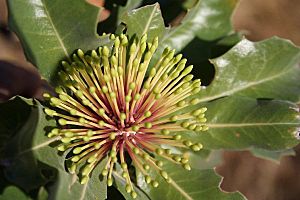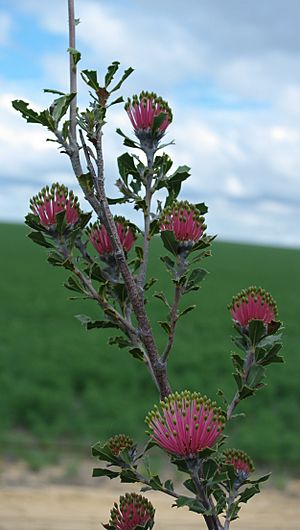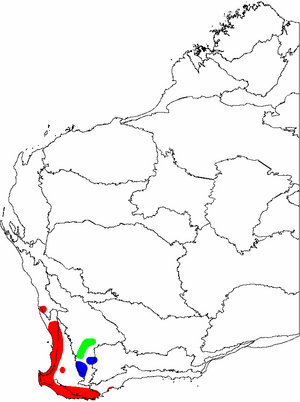Banksia subg. Isostylis facts for kids
Quick facts for kids Banksia subg. Isostylis |
|
|---|---|
 |
|
| Scientific classification |
|
| Kingdom: | Plantae |
| Clade: | Tracheophytes |
| Clade: | Angiosperms |
| Clade: | Eudicots |
| Order: | Proteales |
| Family: | Proteaceae |
| Genus: | Banksia |
| Subgenus: | Banksia subg. Isostylis R.Br. |
| Species | |
Banksia subg. Isostylis is a group of three closely related plant species within the larger Banksia family. These special plants are only found in the southwest part of Western Australia.
Plants in the Isostylis group have unique, dome-shaped flower heads. These look a bit like the flowers of another Banksia group called Dryandra. However, if you look closely, the Isostylis flowers are built more like smaller versions of the tall, spiky flowers you see on most other Banksia plants.
The three species in Banksia subg. Isostylis are:
- B. ilicifolia (also known as the holly-leaved banksia)
- B. cuneata (the matchstick banksia)
- B. oligantha (the Wagin banksia)
B. ilicifolia is quite common and spread out, but the other two species are rare and need protection.
Contents
What do Isostylis Plants Look Like?
Banksia subg. Isostylis plants are known for their compact, dome-shaped flower heads. Even though they look similar to Dryandra flowers, their structure is different. Isostylis flower heads have an oval-shaped center, like a mini flower spike. Dryandra flowers, however, grow from a flat base.
Isostylis plants also have thick, woolly seed pods (called follicles). In contrast, Dryandra seed pods are thin and smooth.
All three Isostylis species grow as upright shrubs or trees, usually with one main trunk. Their leaves are generally serrated (like a saw), though sometimes B. ilicifolia can have smooth-edged leaves.
How Isostylis Was Named and Classified
The History of Isostylis Classification

The group Banksia subg. Isostylis was first described by a botanist named Robert Brown in 1810. This was the first time anyone had organized Banksia plants into smaller groups. Brown created Isostylis for B. ilicifolia, which was the only Banksia known at the time with dome-shaped flowers.
Later, in 1846, another botanist, Édouard Spach, tried to make Isostylis its own separate genus (a larger group than a subgenus). But this idea was not accepted.
In 1856, Carl Meissner changed Brown's subgenera into sections. So, Isostylis became B. sect. Isostylis, still containing only B. ilicifolia. George Bentham kept this classification in 1870.
A big change for Isostylis came in 1981 when Alex George brought it back to subgenus rank. He also added a second species, B. cuneata, to the group. George explained that even though Isostylis looked a bit like Dryandra, it was much more similar to other Banksia plants. In 1988, George added a third species, B. oligantha, to the Isostylis subgenus.
Today, the classification of Banksia subg. Isostylis is generally accepted as:
- Banksia
- B. subg. Banksia (most Banksia species)
- B. subg. Isostylis
Scientists are still studying the relationships between these plants using DNA information. These studies show that Isostylis is a distinct group. They also suggest that Isostylis is related to other Banksia species like B. elegans and B. attenuata, but not as closely to Dryandra.
The exact family tree within the Isostylis subgenus is still being figured out. Different studies have suggested different species as the oldest or "basal" one. There's even a special group of B. cuneata plants that seem to be a mix of B. cuneata and B. oligantha. Scientists are trying to understand if this is a hybrid or a link between the species.
Where do Isostylis Plants Grow?
All B. subg. Isostylis species are found only in the South West Botanical Province of Western Australia.
- B. ilicifolia is quite common. It grows within 70 kilometers of the coast, from Mount Lesueur in the north, down to Cape Leeuwin, and east to Albany.
- The other two species, B. cuneata and B. oligantha, grow further inland and are found in much smaller areas.
- B. cuneata is found near Brookton and Bruce Rock.
- B. oligantha grows a bit further south, around Wagin.
How Isostylis Plants Live (Ecology)
Banksia subg. Isostylis plants are similar to other Banksias in how they live.
Like other Banksias, all three species have special roots called proteoid roots. These roots have many tiny side branches that form a mat just under the leaves. This helps them absorb nutrients very well from poor soils, like the ones in Australia that don't have much phosphorus.
These plants do not have a lignotuber (a woody swelling at the base that helps plants regrow after fire). This means that if a bushfire happens, the shrubs usually die. However, older B. ilicifolia trees can sometimes regrow from special buds on their trunk.
All Banksias, including Isostylis species, release their seeds after a bushfire. This is called serotiny. It helps new plants grow quickly and replace the ones killed by the fire.
Both B. cuneata and B. oligantha are considered rare and protected by laws in Western Australia and Australia. They face threats like losing their natural homes, a plant disease called Phytophthora cinnamomi dieback, and young plants being eaten by feral rabbits.
Growing Isostylis Plants
The B. subg. Isostylis species are not very popular for growing in gardens. The two rare species are almost never grown by people. B. ilicifolia is a bit better known, but its very prickly leaves make it less ideal for planting in places where people might touch it often.
See also
 In Spanish: Banksia subg. Isostylis para niños
In Spanish: Banksia subg. Isostylis para niños



